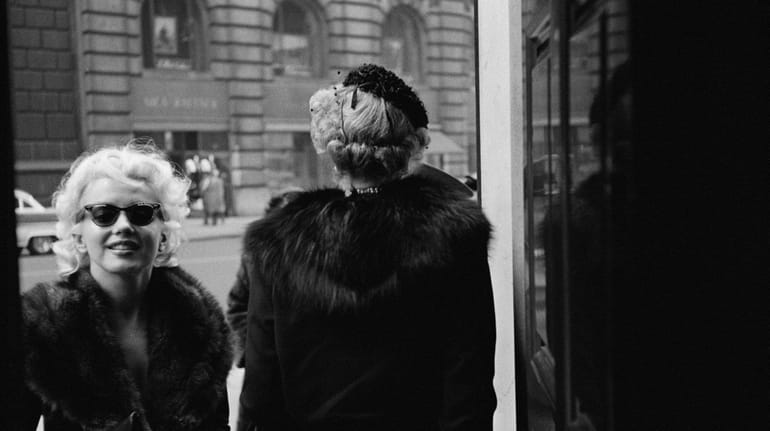‘Marilyn in Manhattan’ review: Elizabeth Winder on the pivotal year that Monroe called New York City home

Marilyn Monroe outside the Elizabeth Arden salon in Manhattan in March 1955. Credit: Getty Images / Michael Ochs Archives / Ed Feingersh
MARILYN IN MANHATTAN: Her Year of Joy, by Elizabeth Winder. Flatiron Books, 283 pp., $27.99.
There is overexposure, and then there is Marilyn Monroe-level overexposure. Every single aspect of the actress’s life has been parsed in hundreds of books and thousands of articles. Writers as disparate as Gloria Steinem and Norman Mailer have been drawn to her complex personality and pondered what her story tells us about fame and womanhood.
Elizabeth Winder’s contribution to the Monroe library, “Marilyn in Manhattan: Her Year of Joy,” focuses on 1955, a year the star spent in New York recalibrating her career and diving into theater, art and literature. It’s an approach that falls squarely within the popular subgenre of micro-biography, in which a short period is held under a magnifying glass and either typifies an entire life or defies conventional wisdom about the subject. Winder followed the same m.o. in her previous book, 2013’s “Pain, Parties, Work: Sylvia Plath in New York, Summer 1953,” which detailed the 20-year-old budding poet’s monthlong stint as guest editor at “Mademoiselle” magazine.
Winder offers a familiar (and slightly ahistorical) empowerment narrative: Just as Plath wasn’t a downer poet but liked partying and putting on pretty dresses, Marilyn was no dumb suicide blonde; she walked around reading Russian novels and kept a photo of Albert Einstein on her bedside table. The book attempts, Winder explains, “to show the real, flesh and blood Marilyn — a strong, savvy woman who took control of her life.”
Except that ultimately she didn’t, and even the book’s subtitle is fraught: Monroe’s “year of joy” was also marked by sustained pill-popping and a passionate but subservient relationship with then-married Arthur Miller, who constantly undermined her.
Winder is at her best when detailing Monroe’s constant search for surrogate families: with fashion photographer Milton Greene and his wife, Amy; with Lee and Paula Strasberg, gods of downtown theater and proponents of Method acting; with writer Norman Rosten and his wife, Hedda. The actress looked for stability and a sense of normalcy but could handle it only up to a point. At times it feels as if she could not function without a certain amount of chaos. And while she could sustain creative friendships with men, she simultaneously encouraged flirtatious ambiguity — Greene, with whom she founded her own company, Marilyn Monroe Productions, is exhibit A. The need to seduce was Monroe’s main survival tool, and her biggest weakness.
But those insights are often undermined by a surfeit of name-dropping and detailed emphasis on food and outfits. At its worst, this makes “Marilyn in Manhattan” read like the literary equivalent of a celebrity Instagram feed. Too bad, because Winder is perfectly able to come up with economical but suggestive descriptions, as when she evokes Monroe’s “soft-serve figure.”
She is less at ease with Monroe’s work and has little affinity for either theater or movies — Otto Preminger’s flawed but compelling “River of No Return” (1954) is casually dispatched as a “goofy Western with a slapdash script” and there is no sense of the importance of “Bus Stop” (1956) in Monroe’s filmography. Nor does Winder provide context for Billy Wilder’s role in the actress’ career, so his criticism appears in a vacuum — “She will lose her male audience,” the director fumed about Monroe hanging out with Lee Strasberg. “She will become a Julie Harris.” Dismissive words, to be sure, especially since there are worse fates than being a 10-time Tony nominee, half of them wins.
In the end, “Marilyn in Manhattan” never makes clear why Monroe had no choice but to be her doomed self. Powerlessness is uncool today, but in her quest to retroactively impart agency to her subject, Winder leaves no room for the tragedy at the center of Monroe’s life.
